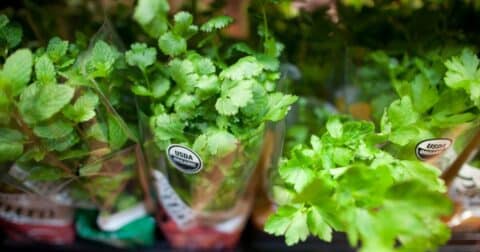Feature
Oklahoma’s Ban on Chinese-Owned Farmland Made an Exception For Smithfield Foods
Food•9 min read
Explainer
‘Organic’ is better for animals — but not necessarily more environmentally friendly or healthy.


Words by Seth Millstein
The organic farming movement has exploded in popularity over the last two decades, and sales of organic food hit an all-time high in 2023. Rooted in principles of sustainability and naturalism, organic principles aim to ensure the long-term well-being of the planet and the people consuming agricultural products. But there are still many misconceptions about what organic farming actually is — and what it isn’t.
Broadly speaking, organic farming is a movement centered on the use of natural, sustainable and environmentally friendly agricultural practices. These practices cover everything from soil health and animal welfare to weather resistance and biodiversity, with an overarching eye toward ensuring the long-term well-being of ecosystems, agricultural land and people who eat agricultural products.
Many people say that the organic movement began in the early 20th century, with early pioneers like Sir Albert Howard, George Washington Carver, J.I. Rodale and Lady Eve Balfour promoting natural and holistic alternatives to intensive agricultural practices and the use of synthetic fertilizers, which had been introduced in 1903.
While this isn’t untrue per se, the general principles behind organic farming are much older than the formal movement itself, and predate all of the aforementioned people by many years.
For example, the world’s Indigenous communities have been implementing sustainable agricultural practices, like intercropping and crop rotation, for thousands of years. The Indian practice of Vedic farming, which prioritizes things like soil health, water conservation and biodiversity, has been around for millenia as well, and was a major influence on the organic movement.
Nevertheless, it was a handful of 20th century figures who popularized these techniques on a global level. Howard, an English botanist, moved to India in 1905 in an attempt to introduce Western agricultural practices to Indian farmers. The opposite happened; Howard quickly realized that the Vedic farming practices he witnessed were producing healthier crops and livestock than the Western farming techniques he’d intended to promote.
Howard, who ended up staying in India for over two decades, wrote several influential books about what he learned, and is considered one of the founders of the modern organic movement.
Other figures who played an important role in popularizing organic farming techniques include Balfour, a farmer who conducted the first scientific comparison of organic and synthetic farming, and Rachel Carson, whose book Silent Spring alerted the world to the dangers of synthetic pesticides, most notably the dangerous and now-banned chemical dichlorodiphenyltrichloroethane (DDT).
In 1990, the U.S. Congress passed a law requiring the United States Department of Agriculture (USDA) to define and formalize organic standards. After receiving advisory from the National Organic Standards Board (NOSB), a 15-member federal advisory committee composed of volunteers from the organic farming community, the USDA created the National Organic Program (NOP), a regulatory program that certifies whether or not products were produced organically.
Nowadays, the label “USDA Organic” indicates that a product was certified as organically produced by the USDA.
At this point, it’s important to note that “organic” and “USDA Organic” are not the same thing. The former is a guiding set of values and principles for farming in a sustainable manner; the latter is a formal certification program by the federal government, with very specific requirements and guidelines.
The distinction is very important, because the standards for USDA Organic are not in perfect alignment with the general principles behind the organic movement.
Organic principles stress the importance of using natural fertilizers and pesticides instead of synthetic ones, and although the USDA Organic program does promote this mindset in a general sense, it doesn’t actually prohibit all synthetic chemicals from farming: there is a seven-page list of synthetic fertilizers and pesticides that farms are free to use while still sporting the coveted “USDA Organic” label.
Complicating matters further is the fact that the USDA actually offers four different types of organic certification:
Yes. The concept of organic farming applies to animals and humans, and the USDA has separate standards for certifying livestock as organic. Broadly speaking, the aim of these standards is to promote the well-being of farmed animals before they’re slaughtered, and reduce their suffering as much as possible when they are slaughtered.
These USDA Organic livestock standards, which were updated late last year, forbid some of the more ghastly practices on factory farms, such as keeping pigs in gestation crates and farrowing cages, removing chickens’ toes to prevent them from scratching, cutting off the tails of cows and starving chickens to induce molting. It also requires that most livestock be afforded a certain amount of living space, outdoor access and ability to engage in natural behaviors, such as preening for chickens or grazing for livestock.
Animals who are raised in accordance with the USDA’s organic livestock standards undoubtedly have a higher quality of life than those who aren’t. But the strength of these standards shouldn’t be overstated, either; they still allow for a number of gruesome practices, like debeaking of chickens and teeth-clipping of pigs, and are much less stringent than other livestock welfare certification programs, such as Animal Welfare Approved or Certified Humane.
Contrary to popular belief, organic food is usually worse for the environment than non-organic food. There are a number of reasons for this.
First, organic farming produces smaller yields than non-organic farming. That’s one of the big trade-offs; in exchange for healthier plants, healthier land, healthier animals and general stewardship of the Earth, farmers have to accept that they’ll produce fewer crops and/or less meat than they otherwise would.
This means that organic farms require significantly more land to produce the same amount of food as non-organic farms. As such, organic farming is worse from a land-usage perspective.
It goes deeper than that, however. One of the functions of fertilizer is to release nitrogen into the soil to promote plant growth, and synthetic fertilizers are designed such that they only release as much nitrogen as the plants need. On organic farms, the prohibition on (most) synthetic fertilizers means that farmers often fertilize their soil with manure instead.
The problem is that manure, unlike synthetic fertilizers, doesn’t release nitrogen in accordance with the plants’ needs, but rather, in response to arbitrary environmental conditions, such as temperature or soil moisture. As a result, organically fertilized soil often has a much higher nitrogen content than non-organic soil.
Why does this matter? Because soil often ends up in nearby waterways, and nitrogen is a dangerous water pollutant that causes a number of adverse environmental consequences. As a result, organically farmed soil often creates more water pollution than the alternative.
Organic food also has a reputation for being healthier than non-organic. At one point, this was certainly true: in the 20th century, DDT and a number of other toxic pesticides were commonly used in American farms, and those pesticides were linked to many adverse health consequences for humans.
By the 21st century, however, most of those chemicals had been banned from farms, organic and non-organic alike. More recent research, including meta-studies in 2012 and 2019, has found little evidence that organic food is healthier than non-organic food.
While most people are familiar with the term “organic,” misconceptions around organic farming abound, even as organic food continues to grow in popularity. The USDA’s Organic program is an attempt to formalize the general principles of organic farming, and while that program has achieved some laudable progress insofar as animal welfare is concerned, it’s not a perfect distillation of organic principles, and it’s certainly not a solution to the environmental damage caused by industrialized agriculture.